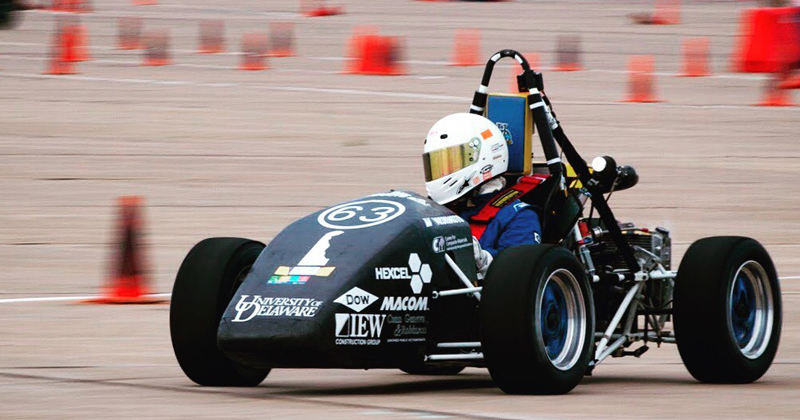University of Delaware Formula SAE team captures highest finish yet
If you dream of building or driving a race car, you can do it at the University of Delaware—all while earning an engineering degree.
Just ask Sean Nelan. The recent graduate, who earned a degree in electrical engineering, led UD’s Formula SAE team, which builds a prototype race car, to its best-ever finish in competition this year. At the annual Formula SAE competition in Lincoln, Nebraska, held from June 20 to 23, 2018, UD finished 23rd, up from 43rd in 2017. Although UD’s Formula SAE team was founded in 1996, they took a hiatus from competition for several years and booted back up in 2017.
For the Formula SAE competition, student teams work together to build cars that are cost-effective and fuel-efficient without sacrificing performance. Cars were judged on cost, presentation, design, acceleration, braking, skidpad (a tight figure-8), autocross (one run down a track) and endurance (a two-driver, 30-lap event). Some teams opt to skip some of the events, but the team from UD completed them all.
“Our big goal this year was to finish all the events,” said Nelan. “We designed our car primarily for reliability, and we met that goal well. In the future, the team will focus even more on the cost, design and business presentations.”
Nelan drove the car during the acceleration test. The team had a problem with the car’s spark coil at one point, but they fixed it within about 15 minutes and kept going.
“It was a bit unnerving at first, but it felt good to push through the engine issues,” he said.
Nelan was one of five drivers. Four of the five drove during the 2017 competition as well, so they were well prepared this year.
This year’s team included engineers from various disciplines as well as students in majors such as finance and hotel management. The students crafted their car in UD’s Spencer Lab, using 3D printers, a new computer numerical controlled (CNC) mill and much more. The team also partnered with the Center for Composite Materials to utilize carbon fiber material in the body of the vehicle.
The team was advised by Steve Timmins, a mechanical engineering faculty member, who said that this year’s team was successful in part because they built upon a solid design utilized in competition previously. The vehicle’s chassis must be built from scratch each year, but other parts and systems can be re-used, he said.
“In 2018 the students focused on optimizing existing designs, rather than starting over from scratch, for most subsystems,” he said. “The focus was more on making it work and designing for durability than for trying completely new (and risky) approaches.
The bulk of the car was designed and built in the FSAE Senior Design capstone course, advised by Timmins. Many of the parts were manufactured before the 2017 Thanksgiving break, leaving time for assembly at the end of the semester, and, more importantly, time to redesign parts that did not work out as planned, he said. Then, in January, a group of five students began working diligently to complete the vehicle.
“For the first time, we had a functional car before spring break, leaving approximately two months for driving, tuning and general debugging,” said Timmins. “It’s important to stress any parts that will break early so they can be redesigned in time for competition, because at competition you get exactly one chance.”
Everything came together for a car the whole team could be proud of.
“The car looked professional, and so did our students,” said Timmins.


